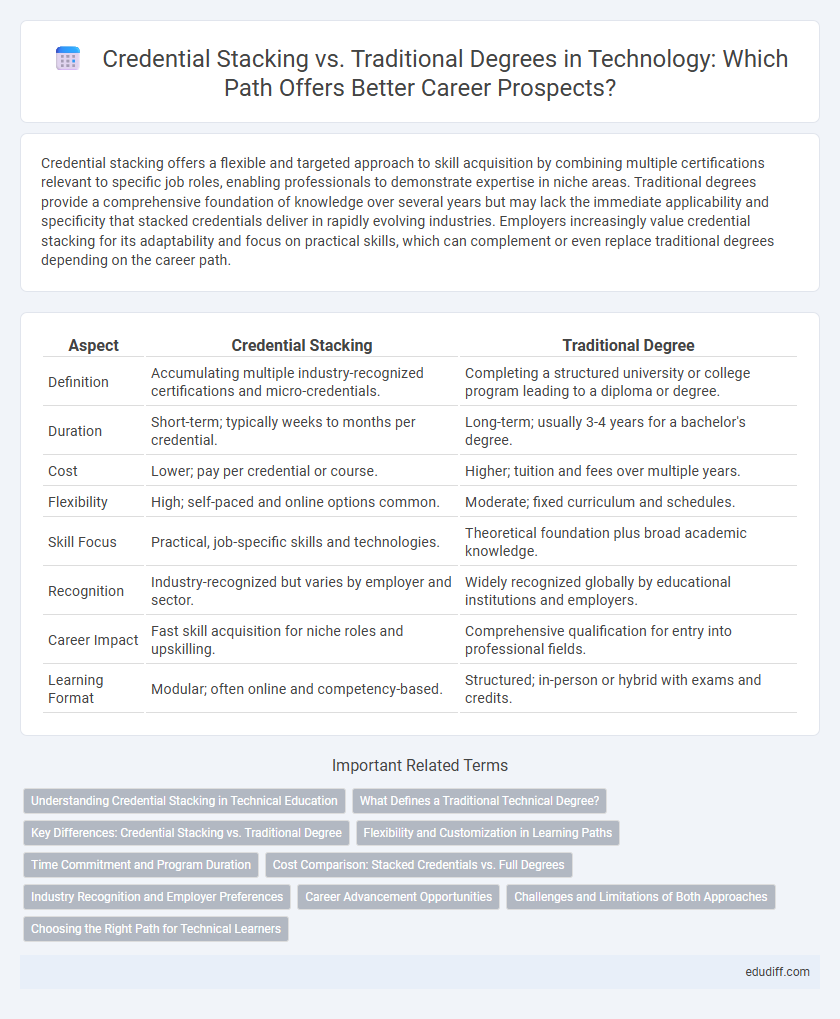Credential stacking offers a flexible and targeted approach to skill acquisition by combining multiple certifications relevant to specific job roles, enabling professionals to demonstrate expertise in niche areas. Traditional degrees provide a comprehensive foundation of knowledge over several years but may lack the immediate applicability and specificity that stacked credentials deliver in rapidly evolving industries. Employers increasingly value credential stacking for its adaptability and focus on practical skills, which can complement or even replace traditional degrees depending on the career path.
Table of Comparison
| Aspect | Credential Stacking | Traditional Degree |
|---|---|---|
| Definition | Accumulating multiple industry-recognized certifications and micro-credentials. | Completing a structured university or college program leading to a diploma or degree. |
| Duration | Short-term; typically weeks to months per credential. | Long-term; usually 3-4 years for a bachelor's degree. |
| Cost | Lower; pay per credential or course. | Higher; tuition and fees over multiple years. |
| Flexibility | High; self-paced and online options common. | Moderate; fixed curriculum and schedules. |
| Skill Focus | Practical, job-specific skills and technologies. | Theoretical foundation plus broad academic knowledge. |
| Recognition | Industry-recognized but varies by employer and sector. | Widely recognized globally by educational institutions and employers. |
| Career Impact | Fast skill acquisition for niche roles and upskilling. | Comprehensive qualification for entry into professional fields. |
| Learning Format | Modular; often online and competency-based. | Structured; in-person or hybrid with exams and credits. |
Understanding Credential Stacking in Technical Education
Credential stacking in technical education involves accumulating multiple industry-recognized certifications and micro-credentials that collectively demonstrate specialized skills and expertise. Unlike traditional degrees, which offer a broad-based curriculum over several years, credential stacking emphasizes targeted, flexible learning pathways aligned with current workforce demands and technological advancements. This approach allows professionals to quickly adapt to evolving technical roles by validating specific competencies through modular credentials.
What Defines a Traditional Technical Degree?
A traditional technical degree is typically defined by a structured curriculum delivered over several years at accredited institutions, combining theoretical knowledge with hands-on laboratory or practical experience in fields like engineering, computer science, or information technology. This degree often requires completion of core courses, elective specializations, internships, and a final project or thesis, culminating in a recognized certification such as a Bachelor of Science or Engineering. Accreditation by recognized educational bodies, standardized credit requirements, and formal assessments are key factors distinguishing traditional degrees from alternative credentialing methods.
Key Differences: Credential Stacking vs. Traditional Degree
Credential stacking involves accumulating multiple specialized certifications or micro-credentials that demonstrate specific skills and competencies, offering flexibility and rapid adaptation to industry demands. Traditional degrees provide a comprehensive, structured education over several years, often emphasizing theoretical foundations and broad knowledge across a discipline. Key differences include credential stacking's modular, skill-focused approach versus traditional degrees' holistic curriculum and longer time commitment.
Flexibility and Customization in Learning Paths
Credential stacking offers unparalleled flexibility by allowing learners to tailor their educational journey through modular certifications aligned with specific skills, bypassing the rigid structure of traditional degree programs. This approach enables real-time adaptation to industry demands and personal career goals, fostering continuous professional development. Unlike conventional degrees, which follow predetermined curricula, credential stacking empowers individuals to customize learning pathways for immediate applicability and diversified expertise.
Time Commitment and Program Duration
Credential stacking typically requires significantly less time commitment compared to traditional degree programs, often allowing learners to complete individual courses or certifications in weeks or months rather than years. Program durations for credential stacking vary according to the specific skills or qualifications targeted, enabling flexible, accelerated learning paths tailored to industry demands. Traditional degrees generally span two to four years, demanding full-time enrollment and structured coursework with less adaptability in program length.
Cost Comparison: Stacked Credentials vs. Full Degrees
Stacked credentials offer a cost-effective alternative to traditional degrees by allowing learners to pay incrementally for each micro-credential, significantly reducing upfront expenses. Whereas a full degree can range from $20,000 to $50,000 or more, individual credentials often cost between $200 and $2,000, making skill acquisition more accessible and flexible. This modular approach minimizes financial risk while enabling continuous professional development aligned with evolving industry demands.
Industry Recognition and Employer Preferences
Credential stacking offers precise, verifiable skills aligned with current industry standards, often preferred by employers seeking specialized expertise over broad theoretical knowledge. Traditional degrees provide comprehensive foundational knowledge and are widely recognized across industries for establishing baseline qualifications. Employers increasingly value credential stacking for its flexibility and direct applicability but continue to rely on traditional degrees for roles requiring extensive formal education.
Career Advancement Opportunities
Credential stacking offers tailored skill sets that align with emerging job market demands, enabling faster adaptation and specialization compared to traditional degrees. Employers increasingly value stacked credentials for their direct relevance and proof of continuous learning, often translating into accelerated promotions and role diversification. Traditional degrees provide foundational knowledge but may lack the agility and specificity critical for rapid career advancement in dynamic industries.
Challenges and Limitations of Both Approaches
Credential stacking faces challenges such as inconsistent recognition across employers and lack of standardized assessment, which can undermine its credibility compared to traditional degrees. Traditional degrees often involve lengthy time commitments and higher financial costs, limiting accessibility and flexibility for learners. Both approaches struggle with aligning rapidly evolving industry needs with curriculum updates, affecting the relevance and applicability of skills acquired.
Choosing the Right Path for Technical Learners
Credential stacking offers technical learners flexible, skill-specific certifications that align closely with industry demands, enhancing employability faster than traditional degrees. While traditional degrees provide comprehensive foundational knowledge and broader career options, credential stacking allows targeted expertise development tailored to evolving technologies. Selecting the right path depends on career goals, industry requirements, and the need for up-to-date technical skills in fields like IT, software development, and cybersecurity.
Credential Stacking vs Traditional Degree Infographic

 edudiff.com
edudiff.com